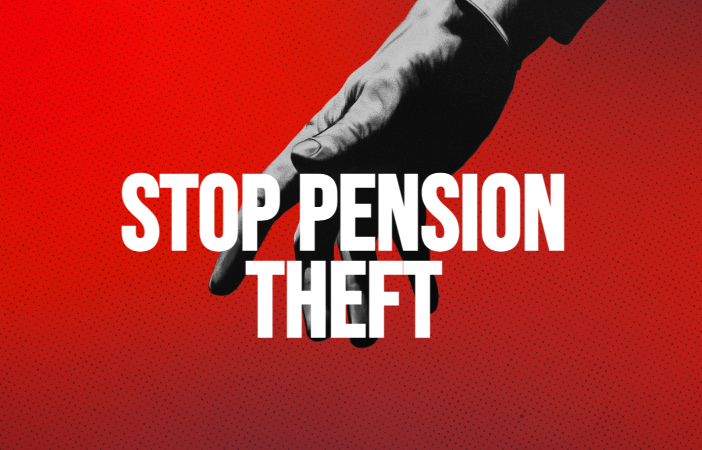
The federal government plans to pocket billions of dollars from the pension plan of unionized public servants. As expected, federal public sector unions are incensed.
On November 25, president of the Treasury Board Anita Anand tabled a special actuarial report in Parliament detailing the financial position of the Public Service Pension Fund. This $186.4 billion fund covers 700,000 federal public servants and territorial government employees. According to the statement released by Anand, the fund had a “non-permitted surplus” of $1.9 billion as of March 31.
In general, a pension fund surplus is a good thing. A well-performing pension fund helps to secure the retirement benefits of plan members and future beneficiaries. Given how frequently workers’ defined-benefit pensions are in the crosshairs of employers, a healthy plan is welcomed news.
However, legislation governing pension funds restricts the size of accumulated surpluses to no more than 125 per cent of the plan’s liabilities. At present, the Public Service Pension Fund’s surplus exceeds this “allowable limit.”
Under these circumstances, the government has the right to transfer the pension surplus into its general revenue. The Liberals have therefore indicated that they intend to move the $1.9 billion surplus into the government’s Consolidated Revenue Fund, into which state revenues are deposited and out of which services and debt obligations are paid. Once transferred, the government believes it may unilaterally determine how to use the money. For example, it could theoretically use federal public servants’ pension surplus to pay down government debt.
Federal public sector unions understandably disagree with the government’s decision to siphon off these pension funds. As the unions see it, the surplus has been accumulated on pension contributions made by both workers and their employer. A decision by the government to transfer this money into its general account and use it as it pleases amounts to theft of workers’ deferred wages.
In response, the Public Service Alliance of Canada (PSAC) has launched a national campaign urging the government to “respect workers and keep its hands off pensions.”
The Canadian Association of Professional Employees (CAPE) is also calling on the government to use the surplus to benefit workers and to “refrain from using their employees’ hard-earned contributions for the government’s own purposes.”
As Jennifer Carr, president of the Professional Institute of the Public Service of Canada (PIPSC), said in a union press release, “This isn’t just free money plucked from Santa’s sleigh. This is our members’ money, their deferred salaries. [...] Federal workers contribute 50% of the money that goes into the pension fund, yet are receiving 0% of this added surplus.”
Moreover, the initial $1.9 billion transfer may be just the beginning. The actuarial report tabled by Anand in November projects that the pension surplus could exceed $9 billion by 2028. As PSAC warns, if the government continues to pocket these surpluses, up to $9.3 billion could be removed from the workers’ pension fund. According to the union, the federal government intends to suspend its pension contributions and remove $7.4 billion from the plan over these years.
As PSAC national president Sharon DeSousa put it, “Workers and [the] employer contribute together to this fund, so why should only the boss get a break? This is about fairness plain and simple. [...] The government flat out lied to us. No wonder, it turns out the biggest holiday present the government is giving this year is to itself.”
The decision to withdraw surplus pension funds without worker consultation or input sets a dangerous precedent, potentially signalling to employers across the country that pension assets are theirs and theirs alone. As PSAC warns, “If the government can poach pension funds from its own employees, what’s to stop other employers from following suit and putting millions more at risk?”
The unions have a legitimate concern. As the Bank of Canada and other central banks raised interest rates in response to post-pandemic inflation, many pension plans posted healthy returns. The Public Service Pension Fund was no different. According to PIPSC, the plan performed very well over the last several years, securing returns of 18.4 per cent in 2021 and 10.9 per cent in 2022.
It’s no stretch to imagine that the government’s decision to pocket the non-permitted surplus from its workers’ pension plan could encourage other employers in both the public and private sectors to do the same. With accumulated surpluses, employers may unilaterally choose to go on “pension holiday” and cease making contributions, or to “de-risk” by offloading bad assets and moving investments in the fund’s portfolio. In either case, employers and their financial advisors will be making investment decisions about funds jointly contributed with workers.
This gets to the heart of the matter. Though workers and employers both make contributions, employers ultimately hold all the decision-making power over workers’ pension plans. If unions were able to influence these decisions, surplus funds would likely be used in more progressive ways, and would certainly benefit members more directly.
For example, federal public sector unions have made their own suggestions for how to manage the surplus. As PSAC contends, the federal government could use the money to suspend or reduce workers’ contributions, invest in fairer pensions for all federal workers, and reverse the two-tier system imposed by former Conservative prime minister Stephen Harper.
Under the current two-tier plan, workers who began contributing after Dec. 31, 2012, are not entitled to the same benefits as those who joined the plan earlier and must work an additional five years before being eligible to retire. According to PSAC, the union proposed a plan six months ago outlining how the government could use a portion of the pension surplus to end this two-tier scheme and return pension fairness.
Unfortunately, the unions face an uphill battle. In 2012, following a similar situation, the Supreme Court of Canada held that the government could lawfully remove surplus pension funds for its own purposes, including to pay its own employer contributions. Unions had taken the federal Conservative government to court over the matter, but the effort to use the courts to limit this practice proved unsuccessful.
Amid the post-pandemic labour upsurge, access to secure pensions re-emerged as a key worker demand. For example, during the auto sector strikes of last fall, workers in both the United States and Canada sought to win back defined-benefit pensions for newly hired union members. Yet the most recent Statistics Canada data shows that despite growth in the number of pension plan members, pension coverage continues its years-long and steady decline. In 2022, only 37.5 per cent of workers had access to an employer-provided pension plan.
When plans face financial challenges — or whenever employers feel emboldened — defined-benefit pensions come under attack. Workers and unions have to fight like hell to defend access to secure retirement benefits. Yet when pensions accumulate surpluses beyond what the law permits, it’s the bosses who again take the money and run.
The case of the Public Service Pension Fund demonstrates the clear need for workers to have greater control over their collective retirement funds. Workers should, at minimum, have a say over what’s done with their money.
Recent Class Struggle Issues
- December 2 | Manitoba’s NDP Government Gets A C+ On Worker Safety
- November 25 | Canada Post Workers Are Fighting An Employer-Led Race To The Bottom
- November 18 | The Federal Government Has Crushed Another Pair Of Strikes
- November 11 | The UCP Has Kneecapped Alberta Education Workers’ Strike Rights







